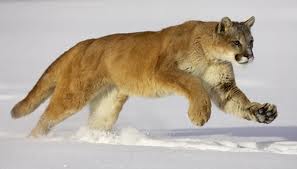Puma
Felis Concolor

Kingdom: Animalia
Phylum: Chordata
Class: Mammalia
Order: Carnivora
Family: Felidae
Subfamily: Felinae
Genus: Puma
Puma is the fifth heaviest of the New World cats after the lion, leopard, jaguar and tiger. These are commonly known as Mountain lion and cougar. It’s scientific name Felis concolor which means ‘cat of one color'.
Evolution
Though they are large in size they are thought to be closely related to feline species. There are 7 subspecies of puma, all of them have similar characteristics but differ in color and sometimes in size.
Distribution
Puma is a large cat mainly dominant in mountains from southern Canada to South America. These are most adaptable are seen in many habitats across the American continents.
Habitat
They live in habitats which are dense bushes and rocky areas for stalking, but it can also live in open plains, coniferous and tropical forests, swamps and deserts.
Anatomy
As they are mostly seen in mountainous regions, they have a thick fur which helps them to keep warm in winters. Depending on the sub species and location the colors vary from brown to yellow and grey to red. Puma is an incredibly powerful predator and has muscular hind legs that are longer than the front legs which make them more agile when jumping. They have big paws when compared to their size. Their eyes are very sharp that they can see objects which are far away. Their ears are pointed and can detect prey by sound if it is dark.
 Prey:
Prey:
Puma is a carnivore and it mainly eats Deer, Rabbits, Mice, Birds and Rats. They can also hunt Sheep’s, Raccoons, Goats and livestock by pouncing on them and catching firmly.
Behavior
Females mark their territories using scrape mark, urine and feces which are also used to attract mates. Males also do the same like scraping together a small heap of leaves and grasses and then urinate on it as a way of marking their territory. Female pumas and cubs are present in groups and males will leave after mating is finished. Pumas are vocal cats and are famous for their low pitched hisses, growls, purrs and screams. Pumas are good climbers and are capable of swimming. Adult Pumas are slender and agile cats who measure 2.4 meters in length.
Lifestyle
Pumas are solitary animals. They travel large distances in search of food usually 80 square miles in the summer to 40 in the winter, as falling snow restricts them in going to longer places. Pumas can hunt effectively during the day or night. Pumas make peculiar sounds when they warn other pumas away from their territory and also during the mating season to attract.
Predators
Puma is dominant in environment and they are not easily eaten by other species. If they are sick or injured then they are eaten by Bears, Wolves and also by other pumas.
Reproduction and Life Cycle
Female pumas reach sexual maturity between 1 - 3 years. Breeding season is between December and March. The gestation period is about three months and up to 6 cubs are born. Once mating is finished male and female part. Puma cubs are totally blind when they are born and it takes 2 weeks for them till their blue eyes open. Adult pumas are in one color but cubs are born with spots on their fur which protects them from their predators. Many Pumas live to an average age of 12 years.
Conservation
The biggest threat for pumas is from humans who hunt them for the sake of fur. And also their number is decreasing due to human settlement and deforestation for agriculture. Pumas are least concerned of extinction as they are adaptable to any kind of climates and hence their population is well sufficient.
References
Please note that the following references may have either been removed or relocated by the webpage owners since the time this student report was created.
“Cougar” Web 31 May 2012. < http://www.kats-korner.com/bigcats/cougar.html>
“Coyotes, Wolves and Cougars… Forever” Web 30 May 2012. < http://coyotes-wolves-cougars.blogspot.com/>
Montijo, Y. 1990. The story of the mountain lion. News From Native California, Spring 1990: 56.
Myers, P., R. Espinosa, C. S. Parr, T. Jones, G. S. Hammond, and T. A. Dewey. 2012. The Animal Diversity Web (online). Accessed at http://animaldiversity.org.
“Puma” Web 26 May 2012. < http://blogeirma.blogspot.com/2009_04_01_archive.html>
“Puma” Web 27 May 2012. < http://www.animalcorner.co.uk/wildlife/puma.html>
“Puma” Web 28 May 2012. < http://a-z-animals.com/animals/puma/>
“Pumas” Web 29 May 2012. < http://www.ipuma.org/site/pumas/>
“The Rain forest rangers” Web 31 May 2012. < http://therainforestrangers.com/uploads/printables/mammal_puma.pdf>
“Wild cats UK Cougar” Web31 May 2012. < http://issuu.com/slimslaney/docs/wild-cats-uk-cougar.>
External Links
http://www.easterncougar.org/
http://www.cougarnet.org/
http://www.mountainlion.org/about.asp
http://www.amazonarium.com.br/docs/peopleandjaguarcomplete.pdf